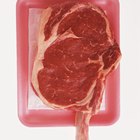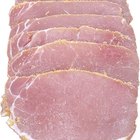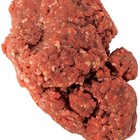
Most types of cooked meat last around four days when properly refrigerated at just below 40 degrees Fahrenheit. Eventually, though, your meat will go bad and you'll need to discard it because of the harmful microorganisms that have caused it to break down and spoil. Before using or reheating any cooked meat, there are certain indicators you can look for to determine whether or not it's still good.
Something Smells Fishy
One of the signs of spoilage in cooked meats is an off, rancid odor. If your meat smells unpleasant or offensive, it's likely spoiled and you should discard it. Icky odors are caused by the gasses emitted by microbes breaking down the meat and feeding on the proteins, fats and carbohydrates contained in it. These microbes, including bacteria, yeast and mold, produce ammonia- or sulfur-like aromas, according to the University of Wisconsin-Madison's Food Research Institute. You'll likely also notice that the meat is soft and slimy when touched. When in doubt about your meat smelling unpleasant, even just a little, it's best to toss it.
Give Your Meat the Once Over
Visual cues are another indicator of spoiled cooked meat. Any discoloration or mold growth on your meat means that it is no longer safe to eat. Mold on the surface appear in a variety of colors and look dusty or fuzzy. Don't sniff visibly moldy foods because mold spores can cause respiratory illness if inhaled. Unlike other types of microorganisms, mold can grow on meats, even salted ones, in the refrigerator, warns the United States Department of Agriculture. These molds aren't just present on the surface of the meats; they are likely embedded deep within them, making them unsafe to eat. Some molds also produce harmful chemicals called mycotoxins which can make you very sick if ingested.
Save the Date
When storing your cooked meats, place them in an air-tight container or plastic bag to keep them moist, and put them in the fridge within two hours of cooking to prevent the growth of harmful bacteria. You can also wrap the meat in plastic or aluminum foil to prevent it from becoming hard and unusable. Mark the date of storage on the package so that you'll know how long the meat has been stored. Check the date before use; if more than four days have passed, your meat is most likely spoiled and you should toss it.
No Taste Tests
Don't take the chance of tasting cooked meat stored in your refrigerator if you suspect that it's gone bad, because many spoilage microorganisms are dangerous when ingested and could lead to foodborne illness. These pests cause all kinds of symptoms once ingested, from simple stomach upset to death in some cases. Another factor is that some meats may taste and smell okay but still contain harmful microorganisms if they weren't properly cooked to 165 degrees Fahrenheit prior to being refrigerated. This temperature kills off nasty pathogens that can make you sick. When you reheat refrigerated cooked meats, check their internal temperature to ensure that it reaches 165 F, which will kill any remaining pathogens.
Related Articles

Can You Cook Meat Gone Bad?

How Do I Tell If Pork Has Turned Bad?

What Does Spoiled Meat Smell Like When ...

How Can I Tell If Lunch Meat Has Gone ...

Rules for Thawing and Refreezing Meat

How to Know When Pork Roast Goes Bad

Can I Eat Pork That Smells Bad if I ...

How to Know if Beef Cubes Are Bad

Should You Cook Raw Meat That's Gone ...

How to Slice a Roast for Jerky

How Long Can Raw Meat Sit Out?

How to Know If Pork Chops Have Gone Bad

How to Know if Bacon Has Gone Bad

Dangers of Spoiled Ground Beef

How to Keep Lunch Meat

How to Salt Cure Jerky

How to Cook Freezer-Burnt Pork Chops

Can You Cook Pork Two Days After ...

If Meat Is Frozen, How Long Does It ...

If Chicken Smells Bad Can You Still ...
References
- United States Department of Agriculture: “Danger Zone” (40 °F - 140 °F)
- Still Tasty: Meat and Poultry
- Foodsafety.gov: Meat in the Refrigerator: How Long Does It Last?
- University of Wisconsin-Madison Food Research Institute: Microbial Food Spoilage -- Losses and Control Strategies
- Foodsafety.gov: Refrigerated Food and Power Outages: When to Save and When to Throw Out
- Texas A&M AgriLife Extension: Introduction to the Microbiology of Food
- American Journal of Agricultural and Biological Sciences: Meat Spoilage Mechanisms and Preservation Techniques: A Critical Review
- U.S. Food and Drug Administration: Bad Bug Book
- Foodsafety.gov: Food Safety Myths Exposed
- United States Department of Agriculture: Molds On Food: Are They Dangerous?
Resources
Writer Bio
Based in Las Vegas, Susan Paretts has been writing since 1998. She writes about many subjects including pets, finances, crafts, food, home improvement, shopping and going green. Her articles, short stories and reviews have appeared on City National Bank's website and on The Noseprint. Paretts holds a Master of Professional Writing from the University of Southern California.
Photo Credits
Eising/Photodisc/Getty Images